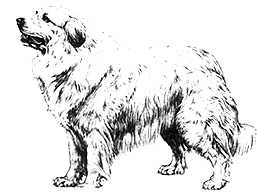Pyrenean Mountain Dog Breed Standard
Last updated: 06 Jul 2011
A breed standard is the guideline which describes the ideal characteristics, temperament, and appearance of a breed and ensures that the breed is fit for function with soundness essential. Breeders and judges should at all times be mindful of features which could be detrimental in any way to the health, welfare or soundness of this breed.

Kennel Club, London 1994
-
Group:
Group 6 (Utility)
-
History:
-
General Appearance:
A powerful and imposing dog with a certain elegance. Great size, strongly built but not cumbersome. Well balanced and of noble bearing.
-
Characteristics:
A natural guard dog protecting shepherd and sheep.
-
Temperament:
Quietly confident. Nervousness and unprovoked aggression highly undesirable.
-
Head And Skull:
Strong head without coarseness, not too heavy in relation to size of dog. Skull curved when viewed from front and sides. Breadth at widest point about equal to length from occiput to stop. Head as viewed from above forms a blunt "V" shape, well filled in below the eyes. Sides nearly flat and of good depth. No obvious stop or excessively protruding eyebrow ridges; only slight furrow, so that skull and muzzle are joined by gentle slope. Strong muzzle, medium length, slight taper near tip. Black nose and eye rims. Liver or pink pigmentation highly undesirable.
-
Eyes:
Almond shaped, dark amber-brown. Close-fitting eyelids set somewhat obliquely, bordered with black. Drooping lower eyelids undesirable. Intelligent and contemplative expression.
-
Ears:
Fairly small, triangular, rounded tips. Root level with eyes. Normally lie flat against head, may be slightly raised when alert.
-
Mouth:
Complete dentition, healthy, strong and even. Scissor bite correct, i.e. Upper teeth closely overlapping the lower teeth and set square to the jaws, but pincer bite tolerated. Two central lower incisors may be set a little deeper than others. Close-fitting lips, upper just covering lower. Roof of mouth and lips black or heavily marked with black.
-
Neck:
Strong, fairly short. Little or no dewlap.
-
Forequarters:
Powerful shoulders lying close to body. Medium angulation between shoulder blade and upper arm. Forelegs straight, strongly boned, well muscled. Elbows not too close to chest, nor too far off, giving adequate width of stance and free-striding movement. Pasterns flexible without weakness.
-
Body:
Broad chest reaching just below elbows; sides slightly rounded, ribcage extended well to rear. Good length back, broad, muscular, straight, level. Dogs usually have more pronounced waist than bitches, giving greater curve to lower body.
-
Hindquarters:
Broad muscular loins, fairly prominent haunches, slightly sloping rump, topline curving smoothly into tail. Strong, well muscled thighs tapering to strong hocks. Stifle and hock of medium angulation seen from side. Strongly made double dewclaws on each hind leg; lack of this identifying characteristic totally undesirable. The hind feet may turn out slightly but legs themselves must be straight.
-
Feet:
Short and compact, toes slightly arched, strong nails.
-
Tail:
Thick at root, tapering gradually towards tip, preferably slightly curled; reaching below hocks, thickly coated with fairly long hair forming attractive plume. Carried low in repose, with tip turned slightly to one side. Tail rises as dog becomes interested: curled high above back in a circle if fully alert.
-
Gait/Movement:
Very free, unflagging and never ponderous. Unhurried, driven by powerful hindquarters. Moving well within its capacity, yet able to produce bursts of speed. Tends to pace at slow speeds.
-
Coat:
Profuse undercoat of very fine hairs; outer coat longer; coarser textured, thick, lying flat and straight or slightly wavy. Longer towards tail and forming mane round neck and shoulders. Forelegs fringed. Long, very dense woollier hair on thighs giving 'pantaloon' effect.
Bitches tend to be smoother coated than dogs and have less-developed mane.
-
Colour:
White
(a) White
(b) White with patches of badger, wolf grey, paler shades of lemon, orange or tan. The colour patches may be on the head, ears or base of tail and a few permissible on body.
Other colours undesirable.
Black patches going right down to the roots highly undesirable.
-
Sizes:
Minimum height:
Dogs 70 cms (27.5 ins) at shoulder
Bitches 65 cms (25.5 ins) at shoulder
Most will considerably exceed this, great size is essential provided type and character are retained.
Minimum weight:
Dogs 50 kgs (110 lbs)
Bitches 40 kgs (88 lbs)
These weights apply only to specimens of minimum height, taller ones should be heavier. Weight always in proportion to height, giving a powerful dog of great strength, but excess weight due to fat undesirable.
-
Faults:
Any departure from the foregoing points should be considered a fault and the seriousness with which the fault should be regarded should be in exact proportion to its degree and its effect upon the health and welfare of the dog.
-
Notes:
Male animals should have two apparently normal testicles fully descended into the scrotum.
 For owners
For owners
 Members
Members
 Dogs Australia is a not-for-profit organisation advocating for the preservation of purebred dogs through ethical breeding.
It champions the highest standard of animal welfare through education and fostering dog-loving communities.
Internationally recognised and established in 1958 as the Australian National Kennel Council (ANKC),
the organisation promotes responsible dog ownership; maintains the ORCHID* heritable canine diseases database;
funds research into canine diseases; and supports state and territory-based member bodies.
Dogs Australia promotes breed conformation shows and community sports for dogs that fulfil a breed’s natural instincts.
Dogs Australia is a not-for-profit organisation advocating for the preservation of purebred dogs through ethical breeding.
It champions the highest standard of animal welfare through education and fostering dog-loving communities.
Internationally recognised and established in 1958 as the Australian National Kennel Council (ANKC),
the organisation promotes responsible dog ownership; maintains the ORCHID* heritable canine diseases database;
funds research into canine diseases; and supports state and territory-based member bodies.
Dogs Australia promotes breed conformation shows and community sports for dogs that fulfil a breed’s natural instincts.







